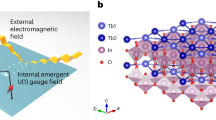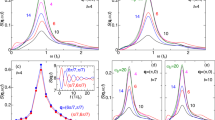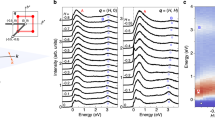Abstract
When viewed as an elementary particle, the electron has spin and charge. When binding to the atomic nucleus, it also acquires an angular momentum quantum number corresponding to the quantized atomic orbital it occupies. Even if electrons in solids form bands and delocalize from the nuclei, in Mott insulators they retain their three fundamental quantum numbers: spin, charge and orbital1. The hallmark of one-dimensional physics is a breaking up of the elementary electron into its separate degrees of freedom2. The separation of the electron into independent quasi-particles that carry either spin (spinons) or charge (holons) was first observed fifteen years ago3. Here we report observation of the separation of the orbital degree of freedom (orbiton) using resonant inelastic X-ray scattering on the one-dimensional Mott insulator Sr2CuO3. We resolve an orbiton separating itself from spinons and propagating through the lattice as a distinct quasi-particle with a substantial dispersion in energy over momentum, of about 0.2 electronvolts, over nearly one Brillouin zone.
This is a preview of subscription content, access via your institution
Access options
Subscribe to this journal
Receive 51 print issues and online access
$199.00 per year
only $3.90 per issue
Buy this article
- Purchase on Springer Link
- Instant access to full article PDF
Prices may be subject to local taxes which are calculated during checkout




Similar content being viewed by others
Change history
02 May 2011
An axis label was replaced on Fig. 4c.
References
Kugel’, K. I. & Khomskii, D. I. The Jahn-Teller effect and magnetism: transition metal compounds. Sov. Phys. Usp. 25, 231–256 (1982)
Giamarchi, T. Quantum Physics in One Dimension (Clarendon Press, 2004)
Kim, C. et al. Observation of spin-charge separation in one-dimensional SrCuO2 . Phys. Rev. Lett. 77, 4054–4057 (1996)
Fujisawa, H. et al. Angle-resolved photoemission study of Sr2CuO3 . Phys. Rev. B 59, 7358–7361 (1999)
Kim, B. J. et al. Distinct spinon and holon dispersions in photoemission spectral functions from one-dimensional SrCuO2 . Nature Phys. 2, 397–401 (2006)
Anderson, P. W. The resonating valence bond state in La2CuO4 and superconductivity. Science 235, 1196–1198 (1987)
Senthil, T. & Fisher, M. P. A. Fractionalization in the cuprates: detecting the topological order. Phys. Rev. Lett. 86, 292–295 (2001)
Wohlfeld, K., Daghofer, M., Nishimoto, S., Khaliullin, G. & van den Brink, J. Intrinsic coupling of orbital excitations to spin fluctuations in Mott insulators. Phys. Rev. Lett. 107, 147201 (2011)
Ament, L., van Veenendaal, M., Devereaux, T., Hill, J. P. & van den Brink, J. Resonant inelastic X-ray scattering studies of elementary excitations. Rev. Mod. Phys. 83, 705–767 (2011)
Moretti Sala, M. et al. Energy and symmetry of dd excitations in undoped layered cuprates measured by Cu L3 resonant inelastic x-ray scattering. N. J. Phys. 13, 043026 (2011)
Ament, L. J. P., Ghiringhelli, G., Moretti Sala, M. & Braicovich, L. &. van den Brink, J. Theoretical demonstration of how the dispersion of magnetic excitations in cuprate compounds can be determined using resonant inelastic x-ray scattering. Phys. Rev. Lett. 103, 117003 (2009)
Luo, J., Trammell, G. T. & Hannon, J. P. Scattering operator for elastic and inelastic resonant x-ray scattering. Phys. Rev. Lett. 71, 287–290 (1993)
Haverkort, M. W. Theory of resonant inelastic X-ray scattering by collective magnetic excitations. Phys. Rev. Lett. 105, 167404 (2010)
Schlappa, J. et al. Collective magnetic excitations in the spin ladder Sr14Cu24O41 Measured using high-resolution resonant inelastic X-Ray scattering. Phys. Rev. Lett. 103, 047401 (2009)
Braicovich, L. et al. Magnetic excitations and phase separation in the underdoped La2-xSrxCuO4 superconductor measured by resonant inelastic X-ray scattering. Phys. Rev. Lett. 104, 077002 (2010)
Le Tacon, M. et al. Intense paramagnon excitations in a large family of high-temperature superconductors. Nature Phys. 7, 725–730 (2011)
Strocov, V. N. et al. High-resolution soft X-ray beamline ADRESS at the Swiss Light Source for resonant inelastic X-ray scattering and angle-resolved photoelectron spectroscopies. J. Synchrotron Radiat. 17, 631–643 (2010)
Ghiringhelli, G. et al. SAXES, a high resolution spectrometer for resonant x-ray emission in the 400–1600 eV energy range. Rev. Sci. Instrum. 77, 113108 (2006)
Hozoi, L., Siurakshina, L., Fulde, P. & van den Brink, J. Ab initio determination of Cu 3d orbital energies in layered copper oxides. Sci. Rep. 1, 1–4 (2011)
Walters, A. C. et al. Effect of covalent bonding on magnetism and the missing neutron intensity in copper oxide compounds. Nature Phys. 5, 867–872 (2009)
Glawion, S. et al. Two-spinon and orbital excitations of the spin-Peierls system TiOCl. Phys. Rev. Lett. 107, 107402 (2011)
Caux, J.-S. & Hagemans, R. The four-spinon dynamical structure factor of the Heisenberg chain. J. Stat. Mech. 2006, P12013 (2006)
Oleś, A. M., Khaliullin, G., Horsch, P. & Feiner, L. F. Fingerprints of spin-orbital physics in cubic Mott insulators: magnetic exchange interactions and optical spectral weights. Phys. Rev. B 72, 214431 (2005)
Neudert, R. et al. Four-band extended Hubbard Hamiltonian for the one-dimensional cuprate Sr2CuO3: distribution of oxygen holes and its relation to strong intersite Coulomb interaction. Phys. Rev. B 62, 10752–10765 (2000)
Brunner, M. Assaad, F. F. & Muramatsu, A. Single hole dynamics in the one dimensional t-J model. Eur. Phys. J. B 16, 209–212 (2000)
Suzuura, H. & Nagaosa, N. Spin-charge separation in angle-resolved photoemission spectra. Phys. Rev. B 56, 3548–3551 (1997)
Macfarlane, R. M. & Allen, J. W. Exciton bands in antiferromagnetic Cr2O3 . Phys. Rev. B 4, 3054–3067 (1971)
Grüninger, M. et al. Experimental quest for orbital waves. Nature 418, 39–40 (2002)
Ulrich, C. et al. Momentum dependence of orbital excitations in Mott-insulating titanates. Phys. Rev. Lett. 103, 107205 (2009)
van Veenendaal, M. Polarization dependence of L- and M-edge resonant inelastic X-ray scattering in transition-metal compound. Phys. Rev. Lett. 96, 117404 (2006)
Acknowledgements
This work was performed at the ADRESS beamline of the Swiss Light Source using the SAXES instrument jointly built by the Paul Scherrer Institut, Switzerland, and Politecnico di Milano, Italy. We acknowledge support from the Swiss National Science Foundation and its NCCR MaNEP. K.W. acknowledges support from the Alexander von Humboldt foundation and discussions with M. Daghofer and S.-L. Drechsler. J.-S.C. acknowledges support from the Foundation for Fundamental Research on Matter and from the Netherlands Organisation for Scientific Research. S.S. and A.R. acknowledge the support of the European contract NOVMAG. This research benefited from the RIXS collaboration supported by the Computational Materials Science Network programme of the Division of Materials Science and Engineering, US Department of Energy, grant no. DE-SC0007091.
Author information
Authors and Affiliations
Contributions
J.S., T.S. and H.M.R. planned the experiment. S.S. and A.R. fabricated the samples. J.S., K.J.Z., V.N.S. and T.S. carried out the experiment. J.S. and M.M. carried out the data analysis. C.M. helped with the data analysis. K.W. and J.v.d.B. developed the theory for the spin–orbital separation with assistance from M.W.H., L.H. and S.N. J.-S.C. provided the theory for the spin excitations. J.S., K.W., K.J.Z., H.M.R., J.v.d.B. and T.S. wrote the paper with contributions from all co-authors. L.P., H.M.R., J.v.d.B. and T.S. supervised the project.
Corresponding authors
Ethics declarations
Competing interests
The authors declare no competing financial interests.
Supplementary information
Supplementary Information
This file contains Supplementary Text and Data, Supplementary Table 1, Supplementary Figures 1-4 and additional references. (PDF 4088 kb)
Rights and permissions
About this article
Cite this article
Schlappa, J., Wohlfeld, K., Zhou, K. et al. Spin–orbital separation in the quasi-one-dimensional Mott insulator Sr2CuO3. Nature 485, 82–85 (2012). https://doi.org/10.1038/nature10974
Received:
Accepted:
Published:
Issue Date:
DOI: https://doi.org/10.1038/nature10974
This article is cited by
-
Multiflavor Mott insulators in quantum materials and ultracold atoms
npj Quantum Materials (2024)
-
Probing magnetic orbitals and Berry curvature with circular dichroism in resonant inelastic X-ray scattering
npj Quantum Materials (2023)
-
Coherent propagation of spin-orbit excitons in a correlated metal
npj Quantum Materials (2023)
-
Witnessing light-driven entanglement using time-resolved resonant inelastic X-ray scattering
Nature Communications (2023)
-
Spin-excitation anisotropy in the nematic state of detwinned FeSe
Nature Physics (2022)
Comments
By submitting a comment you agree to abide by our Terms and Community Guidelines. If you find something abusive or that does not comply with our terms or guidelines please flag it as inappropriate.



